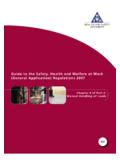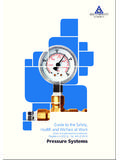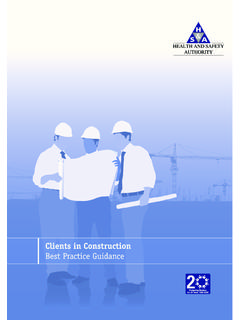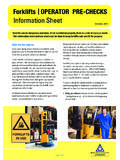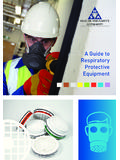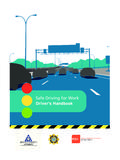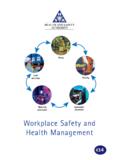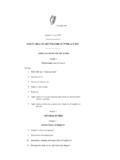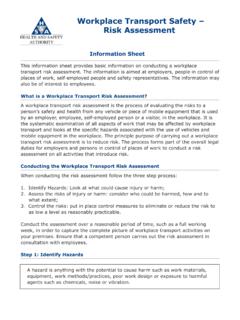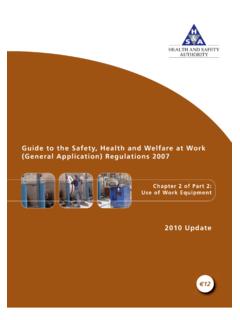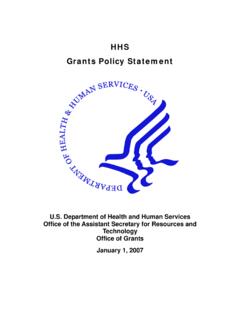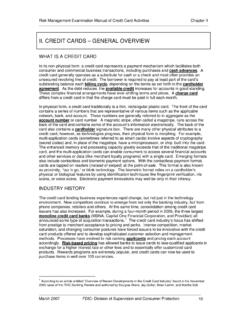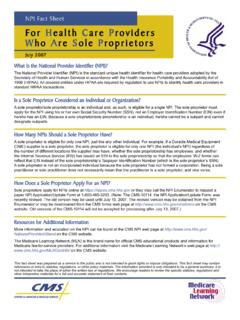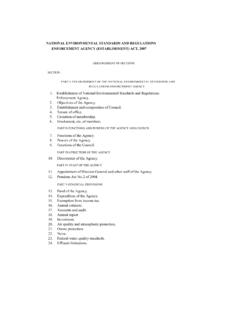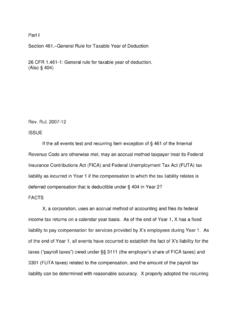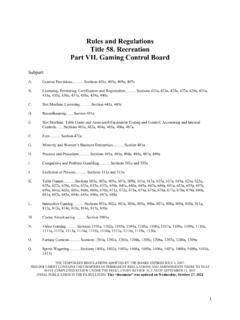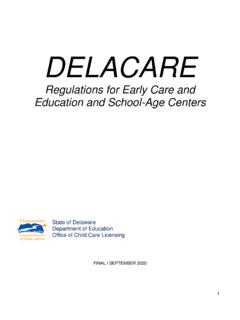Transcription of Guide to the Safety, Health and Welfare at Work (General ...
1 Guide to the Safety, Health and Welfare at Work ( general Application) regulations 2007 . Chapter 1 of Part 5: Control of Noise at Work 7. Control of Noise at Work:Layout 1 30/11/ 2007 12:41 Page 1. Guide to the Safety, Health and Welfare at Work ( general Application). regulations 2007 . Chapter 1 of Part 5: Control of Noise at Work Control of Noise at Work:Layout 1 30/11/ 2007 12:41 Page 2. Published in December 2007 by the Health and Safety Authority, The Metropolitan Building, James Joyce Street, Dublin 1. All rights reserved. No part of this publication may be reproduced, stored in a retrieval system, or transmitted in any form or by any means, electronic, mechanical, photocopying, recording or otherwise, without the prior permission of the Health and Safety Authority.
2 Control of Noise at Work:Layout 1 30/11/ 2007 12:41 Page 3. Control of Noise at Work Contents Introduction 5. general Background Information 6. The impact of noise at work 6. Who is at risk? 7. Regulation 120: Interpretation 8. Regulation 121: Application 8. Regulation 122: Transitional periods 8. Regulation 123: Exposure limit values and exposure action values 8. Regulation 124: Determination and assessment of risks above a lower exposure Action Value 10. Regulation 125: Provisions aimed at avoiding or reducing exposure 12. Regulation 126: Application of upper exposure action values 13.
3 Regulation 127: Prevention of exposure above noise level of 85 dB(A) 14. Regulation 128: Application of exposure limit value 14. Regulation 129: Personal protection 15. Regulation 130: Employee information, training and consultation 16. Regulation 131: Health surveillance, records and effects (as amended) 17. Regulation 132: Exemptions 19. Prevention or Control of risks 20. Appendix: Sources of Further Information 22. Control of Noise at Work:Layout 1 30/11/ 2007 12:41 Page 4. Control of Noise at Work:Layout 1 30/11/ 2007 12:41 Page 5. regulations 2007 .
4 Control of Noise at Work Guide to Chapter 1 of Part 5 of the general Application regulations 2007 . Chapter 1 of Part 5: CONTROL OF NOISE AT WORK. Introduction This Guide is aimed at safety and Health practitioners, employers, managers, employees, safety representatives and others to give guidance on Chapter 1 of Part 5 of the Safety, Health and Welfare at Work ( general Application) regulations 2007 ( No. 299 of 2007 ) as amended from 12 November 2007 by the Safety, Health and Welfare at Work ( general Application) (Amendment) regulations 2007 . ( No. 732 of 2007 ) relating to the control of noise at work.
5 The objective of the Guide is to give practical guidance aimed at the prevention of occupational accidents or ill Health . It is not intended as a legal interpretation of the legislation. The regulations re-transpose Directive 2003/10/EC of the European Parliament and of the Council of 6 February 2003 on the minimum Health and safety requirements regarding the exposure of workers to the risks arising from physical agents (noise). In this Guide the text of the regulations is shown in italics. The general Application regulations 2007 are made under the Safety, Health and Welfare at Work Act 2005 (No.)
6 10 of 2005) referred to elsewhere in this Guide as the Act . From 1 November 2007 , Chapter 1 of Part 5 of the general Application regulations 2007 as amended replaces the Safety, Health and Welfare at Work (Control of Noise at Work) regulations 2006 ( No. 371 of 2006), which are revoked from that date. The regulations come into effect from 1 November 2007 , other than the following exceptions, in accordance with Article 17 of Directive 2003/10/EC: Regulation 122 defers the application of the regulations in the music and entertainment sectors until 15 February 2008; the European Communities (Protection of Workers) (Exposure to Noise).
7 regulations 1990 ( No. 157 of 1990) continue to apply to those sectors until 14 February 2008. Regulation 122 defers the application of the exposure limit value to personnel on board seagoing vessels (Regulation 128) until 15 February 2011. In accordance with Article 14 of Directive 2003/10/EC, separate guidelines will be produced by the Health and Safety Authority to provide practical guidance to assist employers and employees in the music and entertainment sectors to whom the regulations will apply from 15 February 2008. 5. Control of Noise at Work:Layout 1 30/11/ 2007 12:41 Page 6.
8 Guide to the Safety, Health and Welfare at Work ( general Application). general Background Information The basic instrument for measuring noise is a sound level meter. A dosemeter (personal sound exposure meter) worn by the employee can also be used. A calibrator to check the meter and a windshield to protect the microphone against air movement and dirt are essential accessories. Noise is measured in decibels (dB). To address the way the human ear responds to sounds of different frequencies, an A-weighting is commonly applied. The measurements are expressed in dB(A).
9 To measure peak, impact or explosive noises, a C-weighting is applied, which is a wideband frequency weighting, and the measurements are expressed in dB(C). Noise is a measure of pressure on the ear a 3 dB increase in noise represents a doubling of that pressure, so what seems like a small difference in numbers can be quite significant. The Impact of Noise at Work Every day, millions of employees in the European Union are exposed to noise at work and all the risks this can entail. One in five of Europe's workers have to raise their voices to be heard for at least half of the time that they are at work and 7% suffer from work-related hearing difficulties (European Agency for Safety and Health at Work).
10 While noise is most obviously a problem in industries such as manufacturing and construction, it can also be an issue in a wide range of other working environments, from call centres to schools, orchestra pits, bars etc. There is good evidence that a risk to hearing from prolonged exposure to noise exists at levels down to 85 dB(A) and a residual risk down to 80 dB(A). Workers who are regularly exposed to noise levels above 85 dB(A) will be at increased risk of damage to their hearing resulting in noise-induced hearing loss. Noise-induced hearing loss is the most common reported occupational disease in the EU.
